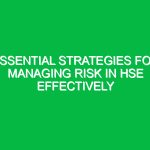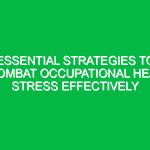Welcome back, team! Today, we’re going to discuss an essential topic that affects all of us: the First Day Back at Work. As we return to our work environment, it’s crucial to prioritize Health, Safety, and Environment (HSE) practices to ensure a smooth transition and a safe working environment. Let’s delve into some key tips and guidelines to make your first day back a successful and secure one.
The Importance of First Day Back to Work
Starting your first day back at work on the right foot is crucial for your well-being and the well-being of those around you. By following proper HSE protocols, you not only protect yourself but also contribute to maintaining a safe workplace for everyone. Let’s explore some key aspects to consider:
1. Preparation is Key
Before your first day back, take the time to review any relevant safety procedures, protocols, and guidelines. Ensure that you are familiar with any updates or changes that may have occurred during your absence. This preparation will help you navigate your return smoothly and confidently.
2. Stay Alert and Aware
On your first day back, it’s essential to stay alert and aware of your surroundings. Be mindful of any potential hazards or risks that may have emerged since you were last at work. If you notice anything concerning, report it immediately to the appropriate personnel.
3. Communication is Key
Effective communication is vital on your first day back at work. If you have any questions, concerns, or observations, don’t hesitate to speak up. Clear and open communication ensures that everyone is on the same page and can address any issues promptly.
Best Practices for a Safe First Day Back
Now that we’ve highlighted the importance of the first day back at work, let’s discuss some best practices to follow to ensure a safe and productive return:
1. Conduct a Safety Walkthrough
Before diving into your tasks, take a few moments to conduct a safety walkthrough of your workspace. Identify any potential hazards, such as spills, obstructions, or faulty equipment, and address them accordingly. This proactive approach sets the tone for a safe workday.
2. Review Emergency Procedures
Refresh your memory on emergency procedures, including evacuation routes, assembly points, and emergency contacts. Knowing what to do in case of an emergency is crucial for your safety and the safety of those around you.
3. Prioritize Personal Protective Equipment (PPE)
Ensure that you have the necessary Personal Protective Equipment (PPE) for your specific role. PPE helps protect you from workplace hazards and should be worn as required. If you have any concerns about your PPE, don’t hesitate to raise them with your supervisor.
Compliance and Regulations
Remember, compliance with HSE regulations and company policies is not optional—it’s mandatory. By following the established guidelines and protocols, you contribute to a culture of safety and uphold legal obligations that benefit everyone. Stay informed, stay compliant, and stay safe.
Conclusion
As we conclude this Toolbox Talk on the First Day Back at Work, I urge each of you to prioritize your safety and the safety of your colleagues. By following the tips and best practices discussed today, you set yourself up for a successful and secure return to work. Thank you for your attention, commitment, and dedication to maintaining a safe working environment. Let’s make every day a safe day!
Remember, safety starts with each one of us. Have a great first day back at work!


